A Comprehensive Guide to Measuring Advertising Effectiveness (+ Expert Tips)

Measuring the effectiveness of an advertising campaign includes:
- Gathering the right data
- Having a system to turn raw data into actionable insights through real-time reporting.
We’ll show you why reporting is essential for advertising success, provide expert input on enhancing your digital advertising campaigns, and show you how to present your reports using DashThis.
What makes an effective advertising campaign and digital marketing strategy?
To understand why some brands outperform others in their advertising efforts, we looked at Gartner’s 2023 list of Genius Brands, a list of top-performing brands in digital marketing and digital advertising across 15 industries like Toyota, Target and Samsung.
These leading brands achieved 10.9 times more site traffic than their peers in 2022 and grew their revenue by 8.6% in 2021 relative to 2020.
Gartner measures hundreds of data points for each brand across four key marketing dimensions.
- Website
- Digital marketing channels
- Social media
- Path to purchase
So what are they doing differently that sets them apart from their peers?
They have a detailed understanding of their customer behavior
Genius Brands served 6.6 times more desktop display ad impressions than peers in 2022 and achieved 9 times more desktop display traffic.
In part, their success comes from tailoring advertising messages and creative elements in their media channels to resonate with their target audience's interests and behaviors.
NewYork-Presbyterian (NYP) dives deep into customer search data and social media trends to understand customer interest, letting them publish relevant content quickly.
Think about:
- Do you understand your target market’s interests and behaviors?
- Can you tailor your marketing campaign’s messaging and creative elements to resonate with the target audience's specific demographics?
They prioritize (and are transparent with) first-party data acquisition
Newsflash: Google plans to phase out third-party cookies in 2024 (unless they shift the deadline again).
This is big news for everyone in digital advertising. Third-party cookies have been the ‘bedrock of digital advertising works for over 25 years.’ Many digital advertising strategies rely on these cookies, like behavioral targeting, retargeting campaigns, and lookalike audiences.
Hence, if digital advertising is a crucial focus for your client or stakeholders, staying on top of shifting privacy practices like the GDPR and doubling down on first-party data and privacy-safe data collection methods is essential.
Shaping your brand image by building trust with your customers and using their data is where Genius Brands excel.
Think about:
- How can you build genuine customer trust in advertising campaigns and digital touchpoints?
- Do you have a system to tap first-party data for smarter retargeting and data-driven omnichannel marketing strategies?
They prioritize data-driven marketing
Genius Brands attempt to understand what their audience wants through data and focuses on meeting these needs on their digital touchpoints.
Louis Vuitton, for instance, uses video storytelling and advertising to capture customers' appetite for video content, resulting in 80% higher page time on their website than their peers.
What being data-driven means for digital advertisers:
- Monitor and analyze ad effectiveness with relevant key performance indicators (KPIs). For example, having a digital marketing dashboard in place to monitor and report on live ad campaigns for your clients
- A/B testing different ad content formats to understand which content format is more effective at driving purchase intent
Why measure and analyze campaign effectiveness?
Here are two ways data becomes your best friend in digital advertising.
Optimize the return on investment (ROI) of your campaigns with data-driven decision-making
Senior stakeholders want to know the ROI of campaigns to prove marketing effectiveness, so it’s essential to understand how to present and report on this metric.
Monitor your advertising KPIs as you optimize your campaigns. For example, you could create a widget to track key Google Ads KPIs in your report to quickly know which changes benefit your campaign metrics and which don’t.

Improve targeting and audience segmentation
You may need to adjust your advertising strategy depending on your audience characteristics.
Let’s illustrate this with an example of how audience segmentation data can help advertisers find an ideal display ad frequency for different audiences.
Studies show that people have different tolerances for a brand's ads depending on their interest level, with those with no interest in the product having the lowest tolerance.
To test this number for your audience and improve campaign effectiveness, you might vary how often you show an audience segment a banner ad based on their past behavior and engagement levels like:
- People unfamiliar with your product
- People aware of the product but not yet interested
- People who have been to your website and are actively engaged
Top 5 KPIs to measure campaign effectiveness for beginners
Start with these KPIs if you need help deciding which ones to analyze.
(Tip: Try our advertising campaign report template if you need these KPIs in a ready-to-use, automated report template.
- Return on ad spend (ROAS): How much revenue you earn from ads per dollar spent on advertising
- Conversion rate: An essential lead generation metric for digital advertising campaigns
- Customer acquisition cost (CAC): How much your business spends to get a new customer
- Click-through rate (CTR): Measures if people are engaging with your ads
- Search impression share: How large a share of the impressions for your chosen keywords your ad campaign is getting. A vital brand awareness metric
For more KPI examples to measure and calculate campaign effectiveness, check out 7 PPC KPIs You Should Be Tracking
How to measure advertising campaign effectiveness with DashThis
1. Define your campaign goals and objectives
Have a precise, quantifiable aim for every advertising campaign you work on. These objectives guide your optimization efforts while giving you a benchmark to evaluate if your campaign is successful.
Here are some simple examples to start:
- Improve brand perception
- Boost website traffic
- Drive conversions
- Improve social media engagement
Getting even more specific with campaign goals beyond conversions or lead generation is possible. Mohaneesh Khubchandani, Director of Demand Gen Marketing at OnBoard recommends introducing new metrics to capture qualified accounts delivered, pipeline generated from campaigns, and revenue attribution.
Adding on, he says:
It’s also important to account for micro-environment factors like the seasonality of certain industries and verticals that can impact the campaign. One of our key verticals is higher education, which operates on a July to June fiscal calendar has well-defined seasonality fluctuation around critical dates such as graduation dates in May and semester breaks. We plan our campaigns around this industry’s seasonality.
How to visualize goals in your DashThis report.
Option 1: Add a note to your KPI widget with details of the goal for the KPI.
Notes show up on your dashboard for easy reference.
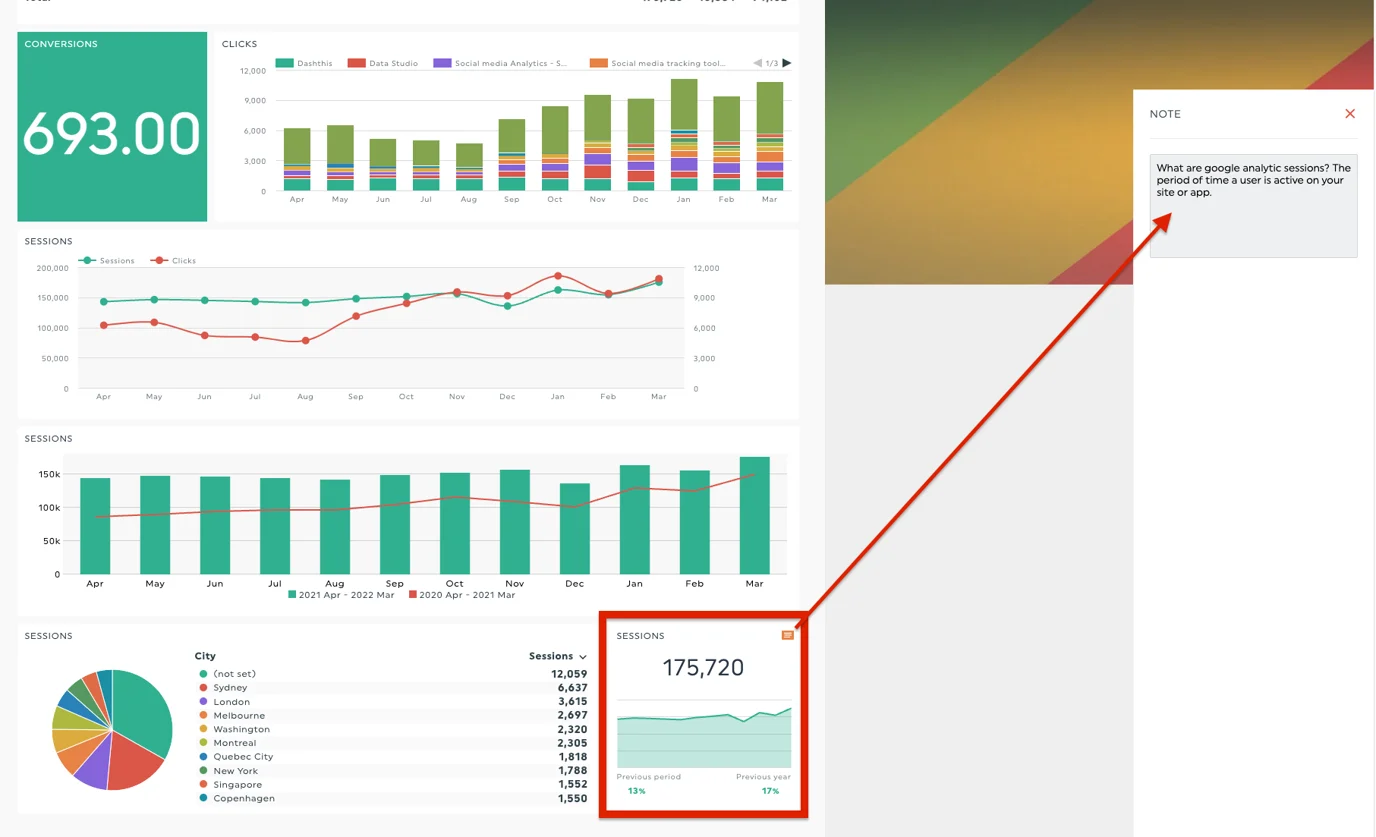
Option 2: Use gauge widgets to visualize and track goal performance at a glance
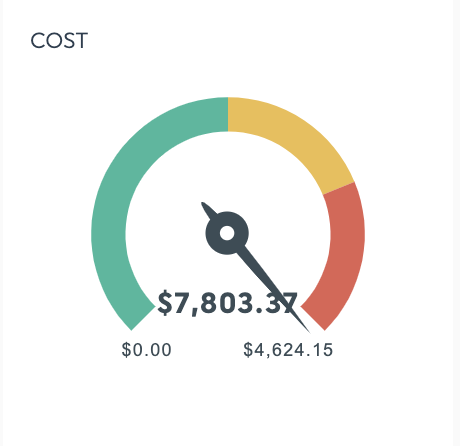
Option 3: Include your goal and objective in a text header
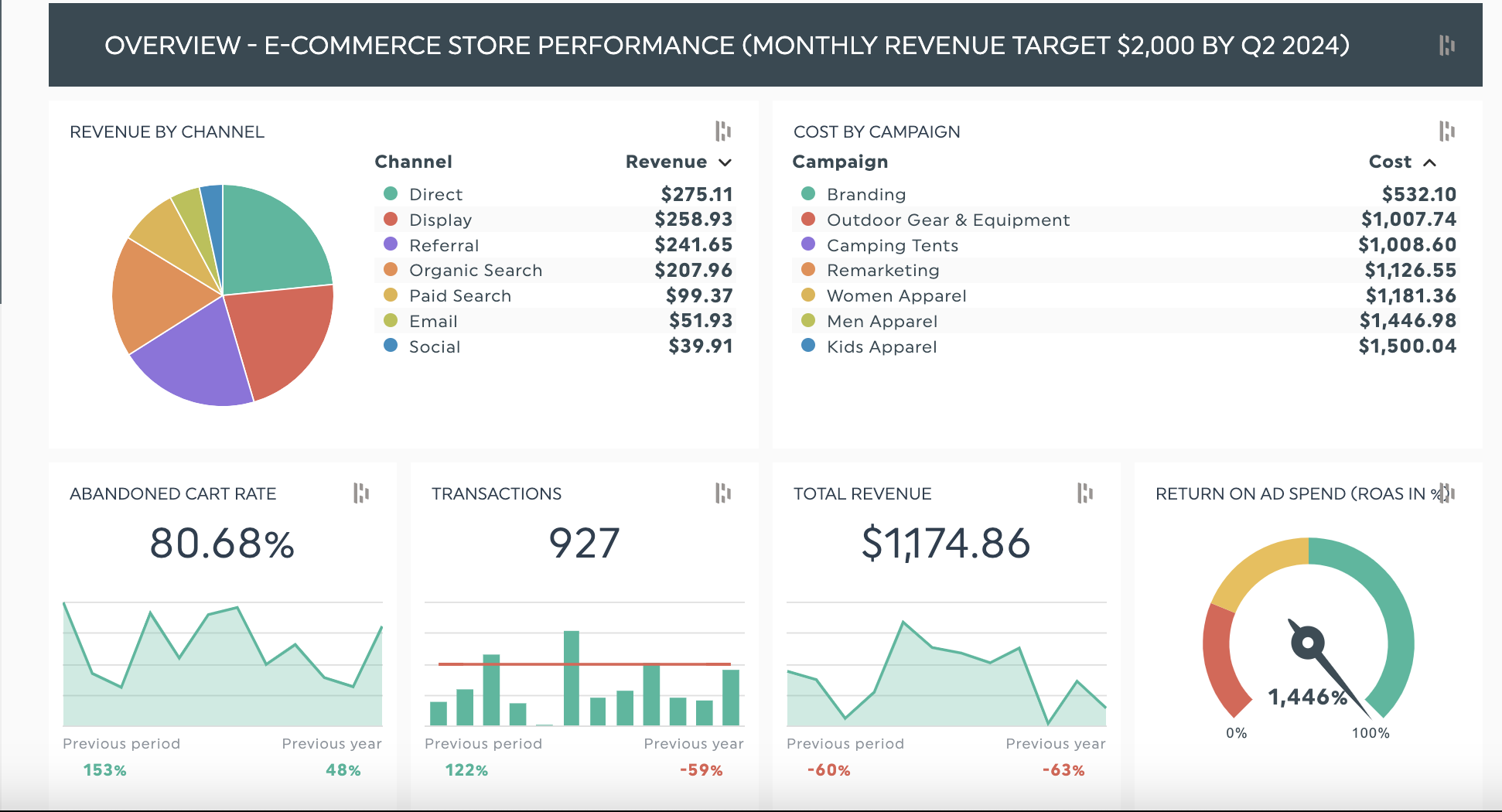
2. Set up tracking and analytics in your digital advertising platforms
Some essential tracking and analytics to set up for digital advertising:
Conversion tracking:
You need proper tracking and attribution to measure the effectiveness of your digital ads. Consider enabling Google Ad’s Consent Mode, which collects data only if the user consents to tracking to improve your conversion tracking, retargeting and personalization efforts.
Read also: How to set up conversion tracking in Google Analytics 4
Enable privacy-safe tracking to improve conversion measurement
Add UTM parameters to your ads
UTM tags that help you track the performance of individual ads and campaigns in Google Analytics. Start with Google’s free Campaign URL builder.
Once you’ve tested these elements to ensure they work correctly, let’s get all your data into DashThis!
3. Connect data sources
DashThis’s 34+ integrations make it easy to connect all your different digital advertising tools to get all your data in one place.
Simply give DashThis access to your accounts and automatically import the data into your DashThis report.
4. Interpret your data
Effective reporting is more than collecting and presenting data. It’s also about interpreting the data.
Analytics consultant Kyle Akerman recommends going beyond describing what happened on our website or marketing efforts by thinking of questions like:
- Why is what happened important?
- What do we do next?
To focus on data interpretation, he suggests starting with a User Story - a statement that helps you understand the problem you’re trying to address through reporting using the format:
As a ROLE, I need/want to TASK, so that OUTCOME.
So for a Google Ads manager, a User Story looks like:
"As the Google Ads Manager, I want to know which Ad Groups perform best, so I know how to allocate my advertising budget."
Report your data in minutes with DashThis’s advertising campaign report template
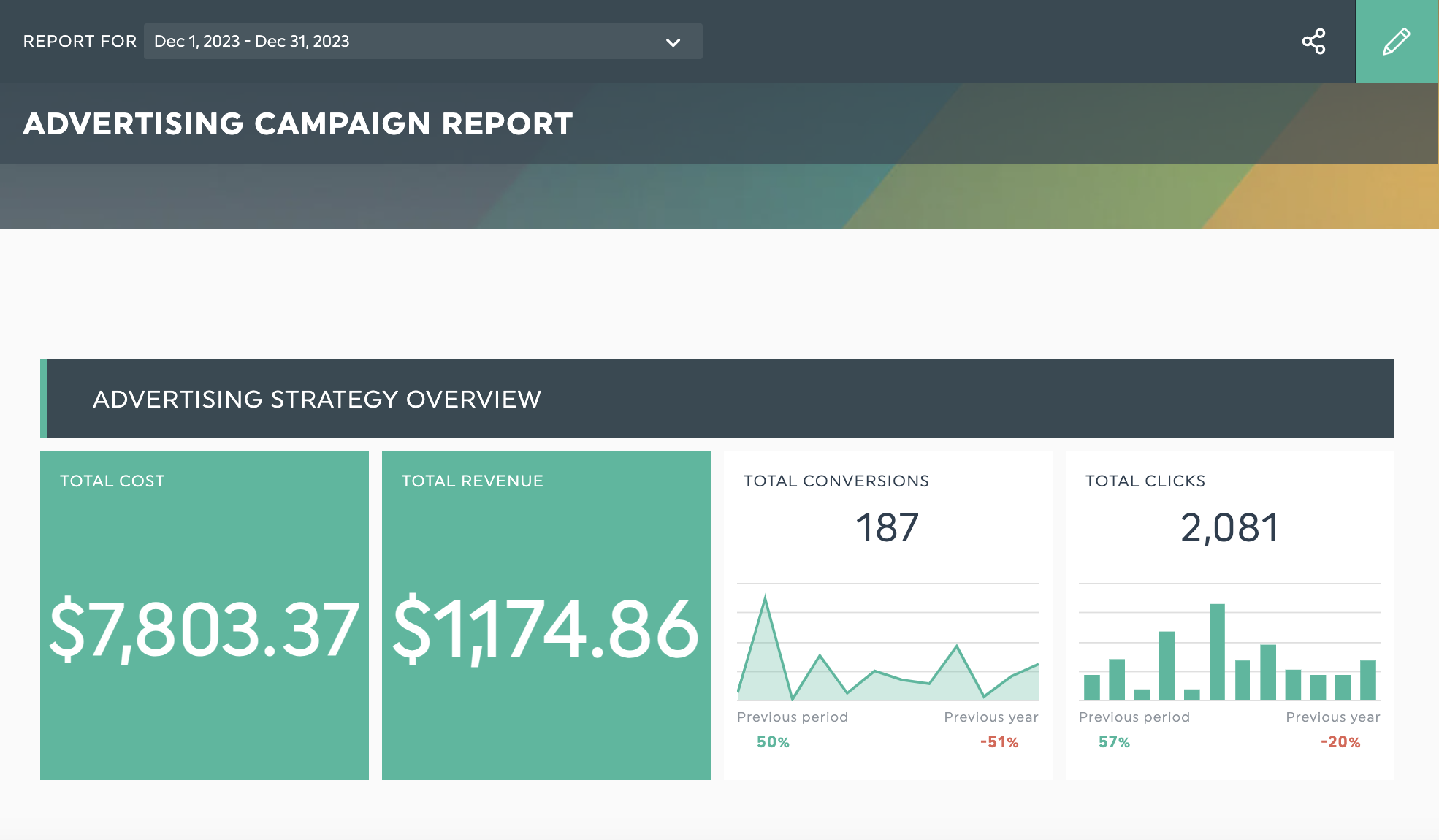
Get this advertising campaign report template with your own data!
This template comes integrated with popular digital advertising platforms like Google Ads, Facebook and Instagram Ads and LinkedIn, allowing you to break down your analysis by channel, individual campaigns or ads.
With everything in one place, it’s much easier to identify successful advertising campaign elements or underperforming keywords to improve.
Try this template for free with your own data with our 15-day trial.
4 practical tips for improving advertising campaign effectiveness
Always keep an eye on your campaigns
For Robert Brandl, the Founder and CEO of Email Tool Tester, “optimizing digital campaigns requires business agility rather than set-and-forget mentalities.”
He continues: A big mistake others make in optimizing digital advertising campaigns is “failing to continually refine targeting, not evolving creative, and not pruning underperforming elements and campaigns.”
He puts this methodology into practice by reducing spending on irrelevant searches yielding lower than 2% conversion rates and reallocating budget into demand funnels exceeding 8-12% signup rates from cold traffic.
Consider scheduling a regular appointment to review your campaign performance and metrics. Set up alerts to monitor your account performance, ad spend and look out for sudden drops in traffic or KPIs.
Use DashThis’s automatic report scheduling to set up a regular daily or weekly report in DashThis to check your campaigns.
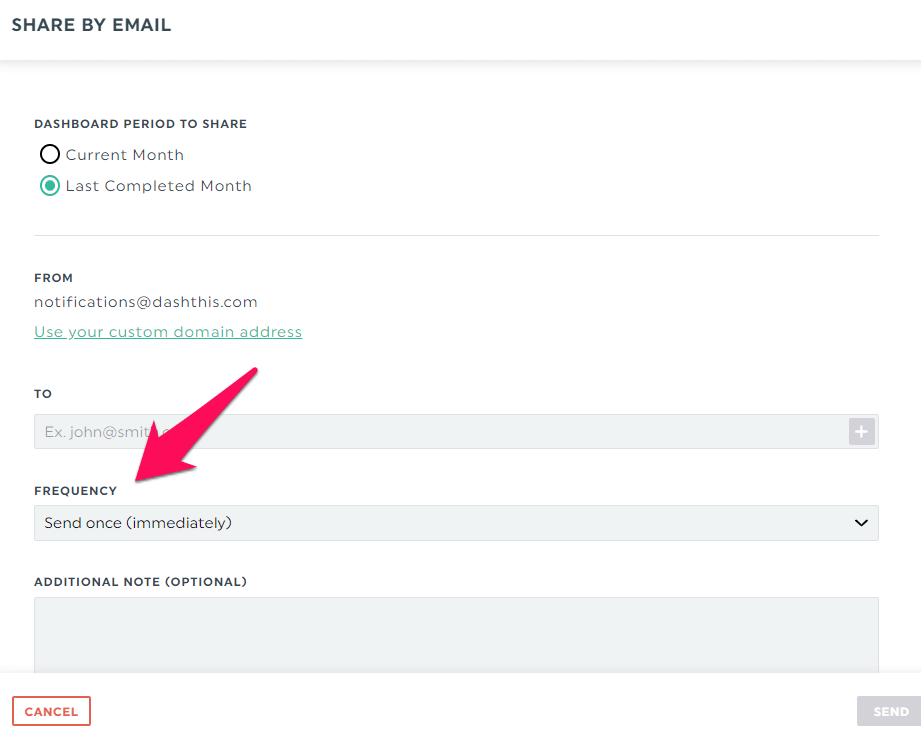
Use A/B testing to optimize your campaigns
How to carry out A/B testing (also known as split testing)
- Find a problem
- Develop a hypothesis of what’s causing the problem and how to solve it
- Quantify your A/B test objective with a key metric
- Create a variation of the element you’re planning to test
- Test the new version against an old version
- Analyze results
A/B tests can apply to any part of your campaign, including ad creative, headlines, call-to-action and targeting parameters.
If all this sounds overwhelming, Nathan Chen, Marketing Manager at Silverstone Technologies, suggests “starting small, with minor variations like headlines or CTAs. This helps you understand user preferences without getting overwhelmed. As you identify winning elements, you can then implement broader changes and scale your success.”.
Ensure your A/B tests have enough time to run. Hardy Desai, Founder & CEO at Supple Digital says:
“You need enough data to make your results reliable, so if you’re a small business with a humble PPC budget and traffic, you need to extend your A/B testing period much longer than a massive website with 10+ million monthly visitors. When you cut your A/B testing short, you risk the quality of your results. And if the data is skewed and inaccurate, you may do more harm than good with any changes you make to your campaign.”
Finally, it’s critical to have a quantifiable objective for your A/B test, as Sarah Jeffries, Founder of Basic Life Support Training stresses. From her experience with A/B testing two ads to improve performance, they found an assertive tone led to a 0.7% difference in engagement versus a subtle tone.
However, it was unclear whether the difference in performance mattered without a precise measure of success defined before running the test. ”Our ad budget was used inefficiently, a consequence of having no clear objectives,” Sarah shares.
Use high-quality creative elements
You only have a few seconds to get your audience’s attention, so your ads must be compelling.
A compelling ad varies by industry and brand, but it starts with knowing what your audience wants and delivering it in a way consistent with your brand and tone and supporting your message.
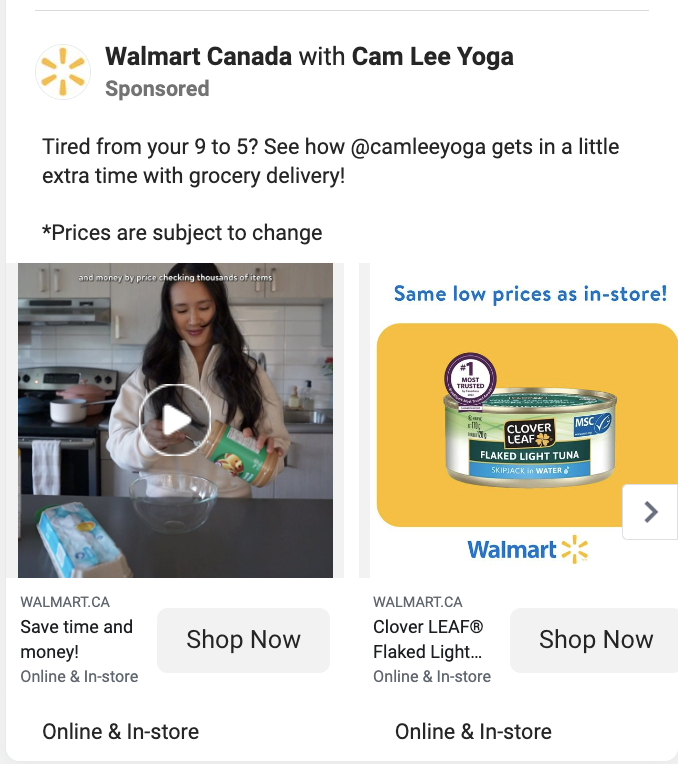
Walmart Canada captures attention with their Facebook and Instagram video ad. It features a creator using their grocery delivery service to save time so she can do more yoga - a relatable day-in-the-life situation for their target audience. The video format makes it easy for viewers to understand the delivery service’s key selling point.
For more live ad inspiration, use the Meta and LinkedIn ad libraries as reference for your next ad campaign.
Re-engage visitors with retargeting strategies
Retargeting ads serve as a gentle nudge to people to remind them of your offer or content. It’s also powerful, with retargeted ads performing 10 times better than display ads alone according to Adroll.
Retargeting is also a powerful technique for retailers, with 51% of retailers tuning to retargeting to retain lapsed or infrequent customers in a 2023 Retail Touchpoints survey.
Zach Spuckler from Heart, Soul & Hustle shares some tips on his podcast on implementing retargeting for your campaigns.
- Increase visibility and conversions during a product launch by retargeting everyone who’s either on your email list, engaged with you on Instagram or visited your website
- Retargeting ads complement organic strategies like email marketing, as not everyone on your email list will see your email
- Retarget an ad to remind people who signed up for your webinar but didn’t attend to watch the replay, especially if you’ve made an offer
Measure your advertising campaign performance effectively with DashThis
If reporting and analytics are something you need help with, let us help you! Give DashThis a try with our 15-day trial, no credit card required.
You’ll be guided by our world-class customer support team (Don’t just take our word for it; check out what our satisfied customers say here.
Measure your ad campaign effectiveness today
Read More
Don’t miss out!
Automate your reports!
Bring all your marketing data into one automated report.
Try dashthis for free

